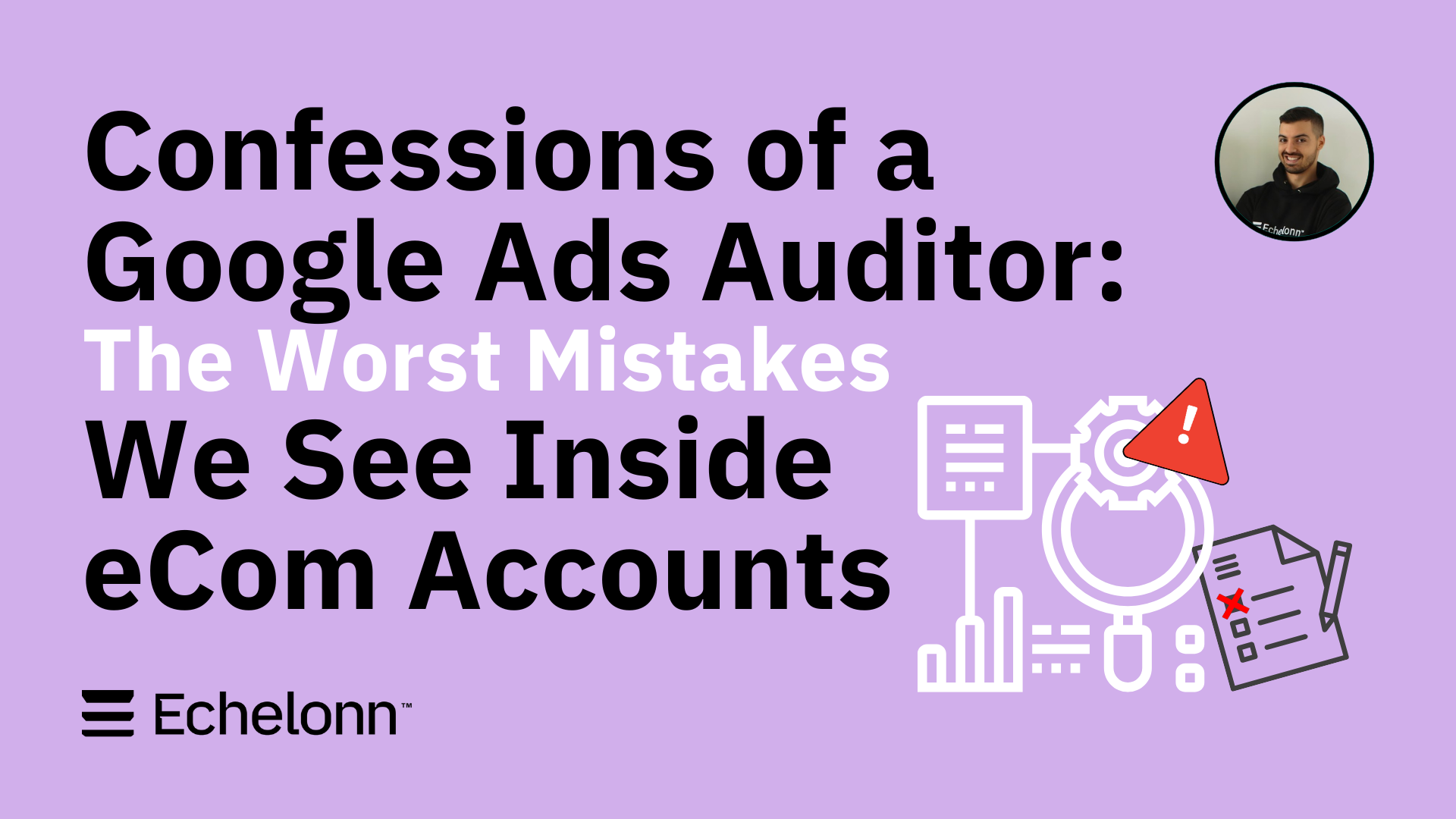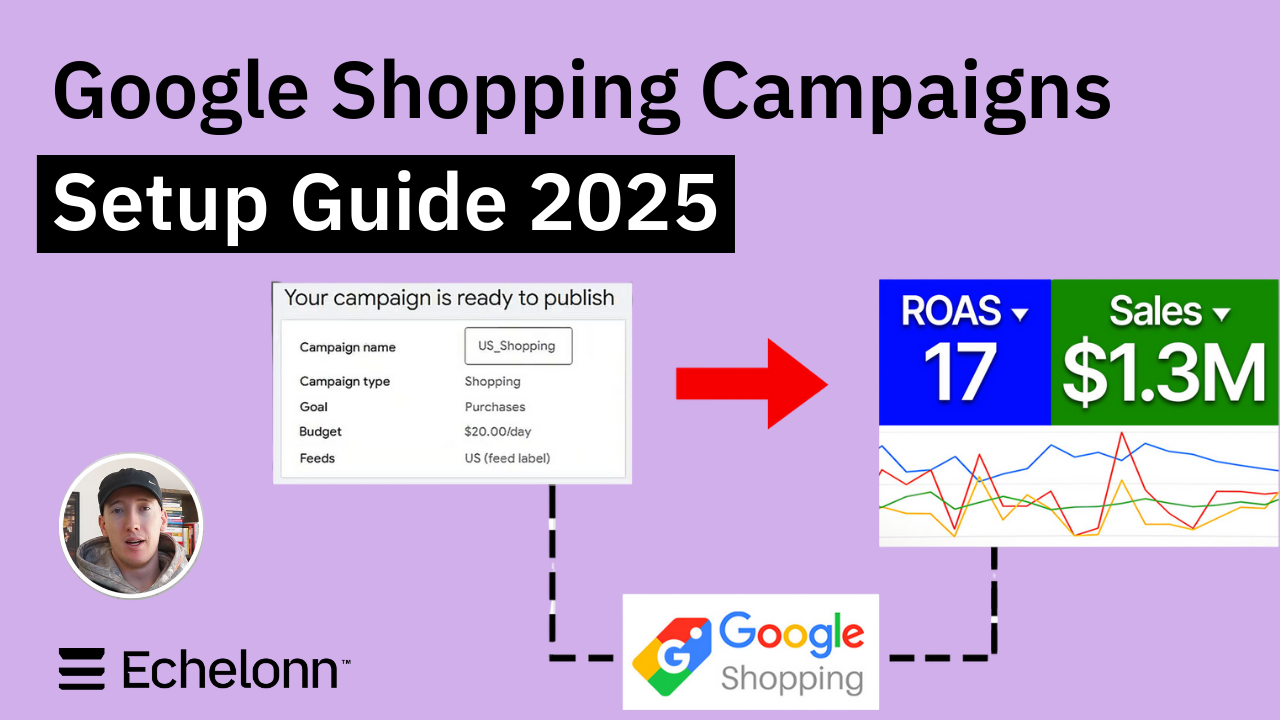Confessions of a Google Ads Auditor: The Worst Mistakes We See Inside eCom Accounts


When we audit Google Ads accounts, campaigns are usually live, and conversions are being tracked. But despite those surface-level signs of activity, major issues almost always lurk underneath. Recurring flaws undermine growth and create drag on revenue.
In this article, we break down the most damaging mistakes we uncover during Google Ads audits; issues that often go unnoticed in day-to-day management but have a compounding effect on performance, profitability, and long-term scalability.
We’ll show you what these red flags look like in real accounts and why fixing them is essential for sustainable growth.
Metrics that mask real problems
Google Ads dashboards often tell a polished story: CTRs are solid, CPCs are stable, and visibility flags look good. On paper, performance appears “well managed. That gloss hides the reality: a dashboard built for reassurance, not for accountability.
In over 500 audits we’ve carried out (and counting), we always trace these metrics back to outcomes:
=> Are clicks converting to customers?
=> Is ad spend driving margin growth?
Often, they’re not. A high CTR might reflect low-intent traffic; tracking conversions but ignoring cost per acquisition ignores profitability entirely.
A deeper audit includes cross-channel analysis. We overlay Google Ads spend with Meta, affiliate, and CRM data. Next, we pin revenue, margin thresholds, and payback periods to each campaign. And finally, we scan for false positives; reports that appear clean but mask spending draining through low-return ad sets.

That shift in perspective transforms reporting into conversation fuel. Suddenly, dashboards surface questions about diminishing returns, rising CPMs, or decaying feed-driven ads. This is what separates superficial maintenance from true auditing.
As Search Engine Land emphasises when discussing metrics:
“When it comes to PPC, success depends on more than just launching campaigns — it’s about understanding and analyzing the right performance metrics.”
Over‑standardised structures
Template builds are efficient to launch, but they consistently fail to scale. A single Performance Max campaign with default settings, a search segment that’s too broad, and a basic retargeting cohort don’t reflect business complexity. Auditing must expose that.
DataFeedWatch highlights how segmentation transforms campaign performance:
“Custom labels can help you organize your products into different categories or campaigns, and track their performance based on factors such as tROAS, seasonality, or overall distribution.”

Proper account structure requires thoughtful segmentation and alignment with business goals. In our audits, we assess how the account is aligned with typical eCom red flags:
=> If branded search accounts for 70–80% of spend, is prospecting real or just noise?
=> Are high-margin products grouped with low-margin SKUs, preventing optimised bidding?
=> Is there structural clarity around SKUs at different funnel stages or seasons?
A well-structured account mirrors the brand’s operational logic: margins separate hero SKUs, custom labels capture product seasonality, and visitor funnels are staged to match creative. From search to Shopping to PMax, architecture matters.
Templates will often hide nuance, but audits always reveal opportunity.
Automation without guardrails
The lure of automation is real: Smart Bidding optimises bids, Performance Max handles channel diversification, and reviews stop. But audits show the consequences of handing off without oversight.

Our common audit findings include:
=> Auto-bidding left indefinitely, followed by rising CPAs, with no responsive action.
=> Performance Max campaigns paused at setup, with no asset rotation or feed check.
=> Dynamic Search Ads running on incomplete website pages, with no negative keyword maintenance.
That disconnect erodes ROI. Smart tools demand strategic oversight, and as Search Engine Land explains, it’s important to be intentional when using AI:
“PPC advertisers must embrace machine learning and feed it the right data to improve performance. … Creative is driving automation.”
Audits should reveal whether automation is managed or abandoned:
=> Does bidding adjust to margin shifts?
=> Is creative refreshed?
=> Are systems adapting in real time?
Without guardrails, automation becomes an engine idling on inefficiency.
Neglected creative signals
When our audits inspect creative performance, they often find assets unused or underutilised. Ad sets run off legacy content, titles remain generic, and inventories cycle through monotonous templates.

Successful audits dig deeper:
=> Are view rates dropping?
=> At what point does ad fatigue hit?
=> Are thumbnail swaps tested to boost CTR?
=> Do YouTube bumper ads align with search intent at each touchpoint?
Strong creative is no longer optional. Today, performance depends on how intentionally you approach creative across formats, placements, and funnel stages.
Every campaign needs a live creative roadmap: hooks for top funnel, proof-driven mid-funnel content, and conversion messaging at the bottom. When audits don’t find that structure, performance is ready to flatline.
Feed issues in campaign strategy
A neglected product feed is a recurring audit alarm. Brands sync once and abandon it, leaving their campaigns to operate on stale or incomplete data. More than just a background task, the feed is central to campaign architecture. Untended, it becomes the weak link that undermines targeting, visibility, and efficiency.
When we audit product feeds, this is what we look for:
=> Optional attributes like size, colour, and custom labels are effectively tied to margins, seasonality, or inventory levels.
=> Correct Google taxonomy and consistently updated feed values so products match shopper queries accurately.
=> Robust QA processes are designed to catch GTIN errors, price mismatches, missing images, or terminated SKUs before they impact campaign delivery.
These elements aren’t optional. They shape how a feed performs, how ads appear, and where budgets get allocated.
“The accuracy of your data feed will determine ad relevance for customer searches.” — DataFeedWatch
It’s never a good idea to think about feeds as data dumps; they’re the scaffolding for entire campaigns. A thorough audit that overlooks feed structure is incomplete by design, leaving room for wasted spend and missed opportunity.
Missing strategic ownership
We often sense this before even digging into the numbers. It’s reflected in the tone.
Audit conversations filled with phrases like “seasonal adjustment,” “learning phase,” or “waiting on creative” are red flags that no one is truly owning performance.
Ownership reveals itself through proactive, strategic questions:
=> Who’s responsible for fixing PLA errors when they arise?
=> How will margin erosion be identified and corrected week over week?
=> What experiments are planned to challenge the current campaign logic?
Without ownership, an audit becomes a passive review.
“Reduced income potential is the price to pay for this kind of feed management. The time it takes to make changes through the IT dept. often prevents advertisers from taking advantage of time-sensitive opportunities.” — DataFeedWatch
Final Thoughts
Thorough Google Ads auditing goes far beyond checklists. It requires shifting from activity to insight, from automation to orchestration, from passive reporting to proactive change. Every click, asset, label, and pipeline must be traced to business outcomes.
It’s important not to think of audits as simply a maintenance log; they’re a strategy blueprint. When executed well, they transform Google Ads from a cost centre into a performance engine where every variable is driven, measured, and maximised for growth.

Ready To Start Scaling Today?
Scaling Your Favorite eCommerce Brands To The Highest Levels Through Google & YouTube Ads.

.svg)
Get Smarter About How To Scale Your Brand...
Discover Insider Knowledge On How We Scale Brands From 7 Figures All The Way Up To 8-9 Figures With Google Ads.
More Articles Like This.
Find answers to common queries about our services and how we can help you.
.svg)
.png)
How to Improve Your Google Ads Conversion Rate
.png)
The Right Way to Link Shopify and Google Ads for Scalable Growth

Google Shopping Campaigns Setup Guide 2025
%20(2).png)
Should You Run Google Ads for Your Website? (Honest Answer)

Confessions of a Google Ads Auditor: The Worst Mistakes We See Inside eCom Accounts

How to Spy on Competitor Google Ads: Complete 2025 Guide
%20(2).png)
7 Questions to Ask Before Hiring a Google Ads Consultant

How to Rank #1 on Google Ads: Complete Shopping & Search Guide 2025
.png)
Learning Google Ads in 2025: The Roadmap Nobody Talks About
%20(1).png)
What Makes a Google Ads Specialist Worth $10,000/Month?

Why Cheap Google Ads Consulting Costs You $180,000+ in Lost Revenue
.png)
Why 99% of Google Ads Experts Fail (& How to Find One That Won’t)
.png)
5 Google Product Feed Fixes for eCom Growth
.png)
Google Ads Campaign Structure: Why 95% of Brands Waste Budget on Mixed Traffic

In-House vs Agency Google Ads: Which Delivers Better ROI in 2025?
.png)
How to Scale Google Ads With a Small Budget | Setup and Optimization

Google Shopping Optimization: 11 Proven Tactics for Maximum ROAS
%20(3).png)
eCom Growth Strategy: How We Scaled a Supplement Brand From $1.9M to $8.6M With Google Ads
%20(4).png)
Google Merchant Center Fix: How to Improve Rankings With Accurate Shipping Times

CTR Is Misunderstood by 95% of the PPC Industry (What to Optimise for Instead)
.png)
Google Ads AI | Manual vs Automated Campaign Performance

Complete YouTube Ads Guide 2025 | 3 Formats, 5 Principles, Proven Results
%20(2).png)
eCom Growth Strategy With Google Ads in 2025
.png)
Google Marketing Live 2025: 11 Key Takeaways for Marketers
%20(1).png)
YouTube Advertising Strategy: How to Drive Results Across Every Format

Google Shopping Feed Optimisation: Tips for Better Results

How Long Does it Take for Google Ads to Work?

YouTube Ads Cost in 2025: How to Launch & Optimize a YouTube Advertising Campaign

Search Ad Strategies to Maximize Sales with Google ads for eCommerce (2024)

2025 Google Shopping Ads: Ultimate Guide, Benchmarks, and Pricing Breakdown


.svg)

.svg)
.svg)





